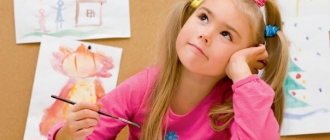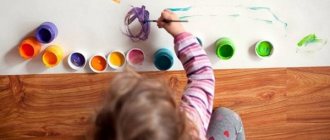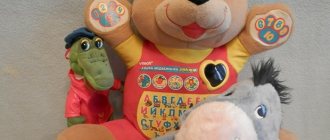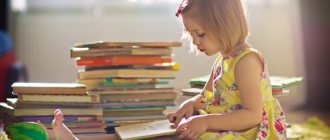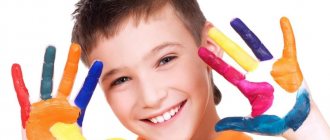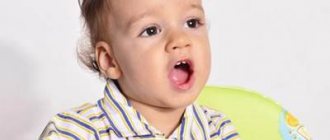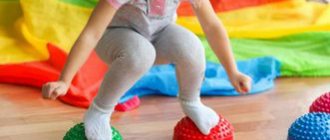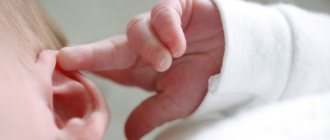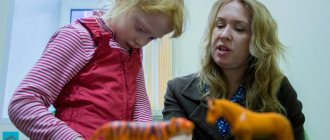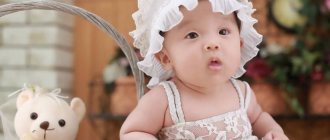A developed imagination is the key to a child’s success in the future. It is this quality that helps you learn easily, engage in scientific and creative projects, and find solutions in difficult situations. A rich imagination shapes a child’s personality and introduces him to the world of art and technology.
However, these qualities do not appear spontaneously in children. If you do not specifically develop them, then by the age of 18 these abilities will fade away.
This article contains effective exercises and tips that will help parents of preschoolers and school students develop their children's imagination and creative abilities.
Why work with imagination in childhood
Two by two is four
The basis of all learning is the reconstructive imagination. The ability to visualize something in your mind based on a verbal description or diagram. Everything that a child has ever seen and remembered, he can reproduce or imagine again.
Recreating imagination is a “path” to memory images. The better this ability is developed, the faster a person remembers and repeats already covered material. Multiplication tables, axioms and theories, historical facts, various definitions of concepts, etc.
But first, children learn to reproduce sounds, intonation, and words. They imitate adults in actions, developing their own line of behavior. The richer such experience, the more successful the process of communication and development of experience of interaction with other people.
“Stick, stick, cucumber - here comes the little man”
The functions of imagination are responsible for the preschooler’s ability to logically process new material, for example, to connect different parts into a single whole. Assemble a puzzle or construction set, determine the system of characteristics by which people belong to a particular profession, etc.
The formation of this skill begins in practice (for example, while playing with multi-colored cubes), later it moves entirely into the realm of imagination and allows you to operate with categories accessible only in theory (for example, the structure of planet Earth).
Ultimately, imagination allows you to connect elements together according to a certain logic, highlight any of them according to one or more characteristics, and restore the overall picture, conjecturing the missing elements.
The flying carpet, the frog princess and the little boy
The development of imagination in children of primary school age allows them to “juggle” various properties of known objects: to combine them, highlight the superfluous, replace, exaggerate some of them, simplify and turn them into diagrams, and much more. Ultimately, a new item will be created or an old one will be upgraded.
This skill allows you to transfer any actions from practice to theory and analyze the possible result. For example, conclude that tea will become tasteless if you add salt to it.
All opportunities for the development of creative imagination in preschool children serve its successful development, socialization and acquisition of useful skills. Ultimately, they give the opportunity to transform the world around them to suit their needs, when a person moves from the role of a subordinate to the rank of creator and manager.
Features of the development of creative thinking and imagination in preschool age.
Development of creative thinking in preschool age
The creative potential of an individual is considered as a characteristic property of an individual, determining the extent of his capabilities in creative self-realization, self-development and self-realization based on moral values.
Creative abilities are individual quality characteristics that determine the success of a person in performing creative activities of various kinds. Since the element of creativity can be present in any type of human activity, it is fair to talk not only about artistic creativity, but also about technical creativity, mathematical creativity, etc. In psychology, it is customary to associate abilities for creative activity, first of all, with the characteristics of thinking.
The development of creative thinking in preschool children involves the formation of the following thinking qualities:
- associativity;
- dialecticity;
- systematicity.
Associativity is the ability to determine connections and similar features in objects and events that at first glance cannot be compared. With the development of associativity, children's thinking becomes elastic and non-standard.
Dialectical thinking allows us to formulate contradictions and find a way to resolve them. Another quality that forms creative thinking is systematicity, i.e. the ability to see an object or phenomenon as an integral system, to perceive any object, any problem comprehensively, in all its diversity of connections; the ability to see the unity of relationships in phenomena and laws of development. The development of these qualities makes thinking flexible, original and productive.
Thinking is considered the more creative, the more distant the ideas between which associations arise; they, in turn, must meet the requirements of the task and be characterized by usefulness.
Thus, one of the main psychological and pedagogical tasks for the development of creative thinking in preschool age is the formation of associative, dialectical and systematic thinking, since the development of these very qualities makes thinking flexible, original and productive. Thanks to the development of associativity, thinking becomes flexible and original. In addition, a large number of associative connections allows you to quickly retrieve the necessary information from memory. Associativity is very easily acquired by preschoolers in role-playing games. There are also special games that help develop this quality. Often discoveries are born from connecting the seemingly incompatible. For example, for a long time it seemed impossible to fly aircraft that are heavier than air. Dialectical thinking allows us to formulate contradictions and find a way to resolve them.
A necessary quality of creative thinking is dialectical thinking, the formation tasks of which in preschool age are:
1. Development of the ability to identify contradictions in any subject and phenomenon.
2. Developing the ability to clearly formulate identified contradictions.
3. Formation of the ability to resolve contradictions.
Another quality that shapes creative thinking is consistency. Systems thinking allows you to see a huge number of properties of objects, capture relationships at the level of parts of the system and relationships with other systems. Systems thinking recognizes patterns in the development of a system from the past to the present and applies this to the future. Let us outline the tasks for the development of systematic thinking in preschool age:
1. Formation of the ability to consider any object or phenomenon as a system developing over time;
2. Development of the ability to determine the functions of objects, taking into account the fact that any object is multifunctional.
In recent years, interest in the development of creativity has increased in psychology and pedagogy. The relevance of studying this phenomenon is determined by the changes that have occurred in the social situation of modern Russia. Under the current conditions, demands on such personality qualities as openness to new experiences and a creative attitude to reality have increased. To do this, it is necessary to activate creative potential, develop creative abilities, creativity, starting from a very early age.
Features of the development of creative imagination in preschool age
Imagination is inseparable from human creative activity, from his behavior. Creative imagination is very important to develop in preschool age. Creative imagination cannot be formed on its own: it develops throughout the child’s life and depends on the conditions of his life, upbringing, and impressions received. Education contributes to the greatest extent to the development of a child’s creative imagination. Creative imagination helps to create new images that are completely different from those stored in human memory. It is an active cognitive process, the result of which is the emergence of new images and objects of reality, products of activity.
Imagination and fantasy are the most important aspect of a child’s life.
Imagination needs to be developed, because... Along with a decrease in the ability to fantasize, children’s personality becomes impoverished, the possibility of creative thinking decreases, and interest in art and creative activity fades.
Imagination is associated with the ability and need to create something new, relying on existing experience.
At the everyday level, imagination is everything that is unreal, non-existent and therefore has absolutely no actual use. But from the point of view of science, imagination is the ability to imagine an object that is not nearby or does not exist in principle, to hold it in consciousness and perform any actions with it.
There are four degrees of imagination activity:
- the lowest activity is expressed in sleep, when perception does not depend on the person’s conscious desires;
- a more active degree manifests itself in pleasant dreams;
- the imagination is even more active while reading, listening to literary works or music, when images are created based on auditory perception or verbal description;
- the highest degree of imagination is realized in creative activity.
Creative imagination is the birth of a completely new image that has never existed before. There are several basic techniques for creative imagination:
- Agglutination (from Greek - “gluing”) is a technique with which characters in many myths and fairy tales are created. For example, a centaur is a horse with the head of a man, Baba Yaga’s hut is a house on chicken legs.
- Accentuation is emphasizing some characteristic of an object, as a result of which it becomes disproportionate. This technique highlights the most significant in each individual image (for example, Pinocchio’s nose is too long). If the emphasis is transferred to the whole image and enlarges it, it is a hyperbole (a huge turnip, which all the heroes of the fairy tale “Turnip” with difficulty pulled out of the ground), and if it decreases, it is a litote (the miniature girl Thumbelina).
Of course, preschool children do not know what the techniques of creative imagination are called. However, children are introduced to them from early childhood by their parents who read fairy tales. And over time, children actively use these techniques to create fictional characters in their own fairy tales and drawings.
The development of creative imagination in preschool children takes place during the process of play. By manipulating real objects, the child invents a fantasy situation. So a child, riding a stick, imagines himself as a rider on a horse. At the same time, the child is not able to imagine a horse if there is no suitable object on which to “ride.”
For children of middle preschool age, it is important that the substitute object has a certain similarity with the object that it replaces. For example, when playing fairy, a girl picks up a twig as a magic wand. In older children, the imagination may start from an object that has little in common with the one being replaced (a child plays with a shampoo bottle, imagining that it is a boat).
Gradually, the need for external support disappears, and a game action can be performed with an object that simply does not exist. This object is endowed with a new meaning, and actions are performed in the mind, and not in reality. At this moment, the imagination is transformed into a mental process, and the imagined situation is brought to life in the inner world of the little person.
The effectiveness of developing the creative imagination of preschoolers largely depends on what methods and techniques the teacher uses when working with children. The main methods and techniques for teaching preschoolers are:
— practical methods (exercises and experimentation);
— visual methods and techniques (use of nature, image, diagrams, technological maps, examination of thematic albums, illustrations, demonstration of methods of action and modeling techniques);
- verbal methods and techniques (story, conversation, instruction, explanations, explanations, reading fiction, etc.);
— gaming methods (didactic, creative, educational games), gaming techniques (sudden appearance of objects and toys, creating gaming situations, playing with images, etc.). All these methods in the process of working with children are used together, in various combinations with each other, and not in isolation. Play methods can be called valuable methods for developing creative imagination, since play is the leading activity of preschoolers and the main content of children's life. In the game, a preschooler, unnoticed by himself, acquires new knowledge, skills and abilities, learns to carry out search actions, think and create. Game methods and teaching techniques help attract children's attention to the task at hand and facilitate the work of thinking and imagination.
As practice shows, the development of creative imagination in preschoolers is well achieved with the help of selected sketches, travel games, improvisation games, and psycho-gymnastics. In psycho-gymnastics, non-verbal imagination is mainly activated.
To develop imagination use:
- Games aimed at creating images based on given elements (recreating images, completing drawings of templates, standards, constructing figures from the proposed details, etc.).
- Games that involve children’s independent creativity and their depiction of their own fantasies (“Model House” - come up with your own collection of clothes; “Looking into the Future” - imagine a car of the future, a house, a fantastic landscape, “Advertising”, etc.).
- Artistic games that contribute not only to the development of imagination, but also the emotional sphere, partnerships (“Shadow Theatre”, “Circus Artists” - come up with an original circus act, “Fashion Theatre”, etc.).
- Mini-sketches. They help to gather children's attention and arouse interest in the upcoming activity. Recreative imagination helps children imagine an image and show it through pantomime. Initially, imitation games are played, then children begin to fantasize on their own.
- Improvisation games can be used in all types of classes, including music, physical education, and choreography. The adult describes the situation (“I am a maple leaf,” “Snowdrop,” “Butterfly”), and children look for an image, showing their creative individuality, and express it through bodily movements.
- Conversation games are planned as a variant of games in which the entire conversation with the child is based on the imagination. These are games in which a child is reincarnated as a living or inanimate creature, in whose image he begins to solve problem situations, give advice, and ask others for something. Games, in addition to imagination, develop empathy, memory, thinking, and dialogic speech.
- Travel games are carried out according to pre-made scenarios and are not carried out visually, relying only on the imagination of children.
Creative imagination plays a very important role in a child's life. On the one hand, this is a flight of fantasy that evokes a storm of emotions, and on the other hand, it is a way of comprehending the world that removes temporal and spatial restrictions.
To develop children’s imagination in the most optimal form in their work, teachers can apply the following recommendations and research methods aimed at identifying the level of development of creative imagination.
Research methods:
1. “Completing the drawing of figures”
Goal: assessment of the ability to complete the construction of a given element as the formation of a new integrity.
Conduct: a set of cards with figures drawn on them, for example: a contour image of parts of objects (a trunk with one branch, a circle-head with two ears) and simple geometric figures - a circle, a square, a triangle), a pencil. There are 10 cards in total. The teacher asks the child to complete each of the figures so that some kind of picture is obtained.
2. “Make a proposal”
Goal: assessment of verbal-figurative creativity.
Conduct: Children are offered a drawing that depicts a Christmas tree, a mouse and a book. The child, looking at the picture, must make as many sentences as possible with these three words in each of them. Any inflection of these nouns is acceptable, but not their omission.
3. “Rearranging the match”
Goal: Assessing the ability to find and use a formative
(an integral element during the transformation of one image into another).
Conduct: The test is based on one of the many types of puzzle games with matches, most of which have “folklore” origins.
What you need are images of a house, a cow, a glass made from matches, a circle cut out of colored paper - a berry (in a glass). The child is asked to rearrange only one match:
a) turn the house the other way;
b) take the berry out of the glass and rearrange only two matches - make the cow look in the other direction.
4. "Non-existent animal"
Target:
assessing the child's general approach to a creative task.
Carrying out:
The child is asked to draw an animal that does not exist in nature and which he has not seen either in books or in cartoons. Then they ask you to name the animal and tell everything about it.
With a truly creative mindset, an absolutely original creature is created. With an artistic and emotional approach, a holistic image of a new, non-existent animal is created, but in the image and likeness of existing ones (vaguely reminiscent of a dragon, heffalump). With a rationalistic approach, a new creature is assembled from parts of real animals (the body of a bear, bunny ears, a bird's tail).
There is no need to limit children’s desire to be different from everyone else in some way, to be original, since this is also a manifestation of creativity. It is necessary, on the contrary, to create the most comfortable conditions for children’s activities, which will become creative only when there is a greater degree of independence in it. Accordingly, then the creative imagination of preschoolers will begin to develop. It is necessary to skillfully stimulate the child to express his creative imagination, and not force him, otherwise all the results obtained will be the same and creativity will not work. It is necessary to observe children, note who has a greater inclination to work with this or that material, in this or that area. For example, noticing that some children have the ability to compose interesting, coherent stories, you can give them the task of composing a story based on a picture, another group of students can be asked to create a series of illustrations for the invented text to make a small book, one of the students can come up with a game based on what was invented and drawn. This stage - collective creativity - is no less significant, since as a result it can result in the appearance of a very original product that is relevant for the entire group. No less important is the development of the creative imagination of older preschoolers outside the preschool educational institution, at home, in the family. The development of children’s creative imagination and fantasy depends on what books parents read to their children, what types of creativity they engage in together, even on how they answer their children’s questions. Thus, adults play a major role in developing children's creative imagination. It is necessary to develop it consistently, systematically, paying great attention to the personality and individuality of each student.
Development of imagination in preschool children
Many parents are surprised by the things that their child has imagined: games, plots of drawings, fears, some non-existent events in life. The thing is that adults have already lost a significant part of the possibilities of their imagination, and children’s imagination begins to develop quite early and takes up most of their cognitive activity.
The development of imagination in children of primary school age is closely related to the visual arts. By recreating already familiar images, the child can transform them in accordance with his vision of the world, obtaining new themes.
The development of imagination is closely related to the desire of preschoolers to try new activities. Parents can take advantage of this by creating the necessary conditions to stimulate the child to study: prepare various types of paper (corrugated, crepe, velvet, glitter, watercolor, parchment, etc.), organize a work space (table, chair, two-way lighting, a set of office tools, hand wipes), etc.
The development of imagination in preschool age goes through several stages:
- From birth to 3 years of age, imagination is very weak. The child is engaged in “gathering information” - studying the properties of objects, their influence on his condition. All mental processes are formed in conjunction with each other, therefore, for the active development of imagination in the future, it is important to properly organize the space around the child. It is important that relationships in the family are loving and harmonious, that the child is given the opportunity to freely study the diverse phenomena and objects of the surrounding world, and that a healthy daily routine is established.
- At the age of 3, most children have already discovered the possibilities of verbal speech and can give objects born of their imagination a form for expression. The formation of imagination as an independent process and as part of cognitive activity depends on this. At this time, you should pay attention to increasing your vocabulary; for this you need to talk a lot with the child, listen to audio fairy tales, learn poems and songs.
- 4-5 years is the age at which fantasy becomes a necessary element of role-playing games. During this period, it is important for parents to create conditions for “reincarnation”: keep the child active, invent or buy costumes, items for games, and participate themselves. These can be games of a cook, a salesman, aliens, a school student, etc. This kind of activity is an excellent way to develop imagination, introduce the child to existing social relationships, and prepare for various social roles in the future. Ultimately, this is a preliminary stage of active creative activity.
- 6-7 years is the age at which imagination is actively applied. A child at this age can already occupy himself independently: draw, color, create a collage, cut, make simple crafts. He is already planning his employment, can prepare materials for the game and think through its scenario. During this period, it is important for parents to properly organize their child’s time, paying attention to preparation for school, that is, regular developmental activities that bring benefit and joy to the child.
When a preschooler is receptive to the development of creative imagination
In psychology, the stages of development of the creative imagination of preschoolers are conventionally distinguished.
The initial stage appears when children, already knowing the real purpose of an object, use it in a new capacity. A replacement appears, but only an object that is somewhat similar (shape, color...) is assigned to the role of “substitute”. For example, imitating measuring temperature, a preschooler will take a stick as a thermometer; and handing an orange ball to a peer, he will start talking about orange.
During this age period, it is useful to show your child how to find new uses for ordinary materials. For example, you can show him different ways of drawing - with a brush, pencil, charcoal, chalk, etc.
Drawing with children 3-4 years old does not mean creating specific drawings. Kids depict scribbles, spots, chaotic strokes. And then, with the help of adults, they see something in the drawn lines and curls. At this age, it is important to broaden the child’s horizons so that he develops a stock of knowledge on which he will rely in his creativity.
From reality to fantasy images
At the next stage, at 4-5 years old, previously acquired skills are improved. Fantasy is still based on the idea of a real object, and new images appear unintentionally. Therefore, even a 5-year-old child will rarely respond to an offer to compose a fairy tale. He is not yet able to complete such a task at the request of an adult.
Younger preschoolers can perform certain actions and then tell what happens in their game or activity. This means that the intention is formed after the action. In such situations, creative imagination also takes place, but its level is only initial.
Children 6-7 years old can already demonstrate independent creative activity. They are able to choose a goal, formulate a creative idea and strive to realize their plans. Imagination is based on the development of creative abilities in preschool children. Older children are already able to include any small element into the overall composition, imagine the expected result before it appears, combine disparate details with one idea, etc.
At this stage, the process of fantasy itself captivates. Parents often notice that their son or daughter comes up with ideas “on the fly.” This skill is especially evident in the writing of stories by older preschoolers. A significant breakthrough occurs due to the general development of the child’s cognitive sphere and the enrichment of speech.
Exercises to develop imagination in preschoolers
The question of how to develop a child’s imagination can be answered: activities with a child vary depending on personal family preferences: you can attend special developmental schools or organize them at home. In the second case, the following exercises are perfect:
- Offer your child blanks (geometric figures drawn on paper or cut out, for older children - three-dimensional figures (cone, pipe, cube, etc.) and ask them to draw or glue new elements to it to make something original. The result may be: animals, objects, cartoon characters, etc.
- Assemble the puzzle. This can be an option from a store or made independently. To do this, you need to cut the picture on thick paper into several parts.
- Prepare flat geometric figures from colored paper or felt in advance, and invite your child to assemble a collage from them. It could be a bird, a house, a Christmas tree, etc.
- Invite your child to create their own house and help with the choice of materials. Sofa cushions, polypropylene rugs, bedspreads, boxes, etc. can be used.
Development of imagination in primary school age
Like the development of creative imagination in preschool children, the process of developing fantasy and creative opportunities for schoolchildren should contribute to positive personal development, be diverse and aimed at studying the social structure and knowledge of the world around them.
All activities are still of a gaming nature, but at a different level of complexity. It is important to include elements of self-control in classes and involve them in various types of activities. The more the child can do on his own, the better.
As a rule, parents and schools begin to make serious demands on their children as soon as they receive a new status, “first grader.” One involuntarily compares the capabilities and achievements of children. Parents should praise the results of their child’s work (“I like what you did,” “I’m glad you did it faster today,” “I love it when you do that,” etc.).
It is better to exclude comparisons with what other children have achieved: you need to monitor how the baby develops and compare only with the results that he received before (“I’m glad that today you did it yourself, without the help of adults,” “I I really like your drawing, all the lines in it are neat and it’s very bright”).
To develop imagination in free applied creativity classes for younger schoolchildren, it is important to avoid ready-made templates (“this is right, but this is wrong”), more appropriate formulations would be: “what should I do to make it a little neater?”, “I want to consult with you on what to come up with.” , to…". When it is important to teach a child some technique or technique, you should stipulate this: “now I will help you learn how to do ... there are certain rules that you need to follow.”
Discussing the task before class allows you to protect free creativity from criticism if the parents and the child have not agreed in advance what they are doing: learning to carefully follow the copybook (mom’s position) or drawing a variety of fancy scribbles (child’s opinion).
During this period, it is important to support parents in learning new material in academic subjects, but creative activities should not be relegated to the background, since only 1-2 lessons are devoted to them in the school curriculum.
The child’s cognitive activity during this period should be of a research nature, so that the student independently finds the materials he needs for learning. Open problems to solve, puzzles, mazes, etc. should be offered.
To develop a child’s attitude towards changed living conditions (the inclusion of school), and to himself, a positive attitude from parents, joint activities, weekend walks, and travel are important. It is necessary to include a playful moment in those activities where possible. All this develops and creates fertile ground for the development of imagination.
A negative influence in this regard will be the demands of the school and parents to “study well” (you must, look, this boy studies well, etc.) without paying attention to the needs of the child himself.
Article:
Everyone knows that human mental processes are divided into:
- Cognitive; sensation, imagination, perception, memory, thinking, speech.
- Emotional.
- Strong-willed.
Our article is devoted to such a mental process as imagination, which is closely related to all other cognitive processes.
Imagination is the mental process of creating new images, ideas and thoughts based on existing experience, by restructuring a person’s ideas. It can be active or passive.
Active imagination is a condition for human activity. It is divided into recreative and creative.
The reconstructive imagination is formed on the basis of nature, a city landscape, a verbal portrait, a diagram, a drawing, etc. In this sense, a person seems to fill the source material with the images he has.
Creative imagination is the process of creating new images that do not exist in reality, which contributes to the development of initiative and human independence.
Imagination can also be passive, leading a person away from reality and away from solving practical problems. A person seems to go into a world of fantasy and live in this world, doing nothing and thereby moving away from real life.
The value of a personality is determined by what types of imagination predominate in it: the more active and significant, the more mature the personality.
Imagination can be involuntary and voluntary.
Involuntary imagination is a process in which new images arise in a person’s mind without a predetermined goal, of course.
Voluntary imagination is carried out deliberately, in connection with a predetermined goal. A person, imagining, searches, selects, combines and mentally transforms his ideas, shows conscious efforts.
Thus, imagination is one of the cognitive processes that characterizes a certain level of development of a person’s consciousness and his creative potential.
Creativity is an activity that generates something qualitatively new and is distinguished by originality, originality and uniqueness.
L.S. Vygotsky formulated three laws of RTV (development of creative imagination). 1. The creative activity of the imagination is directly dependent on the richness and diversity of a person’s previous personal experience. Therefore, we need to help the child accumulate knowledge, experience, and images if we want him to be a creative person. 2. You can imagine something that you haven’t seen yourself, but have heard or read about, that is, you can fantasize based on someone else’s experience. 3. The content of imaginary objects or phenomena depends on our feelings at the moment of fantasy. Conversely, the subject of fantasy affects our feelings. You can “fantasize” your future in such a way that it will be a guide for your whole life, or you can imagine horrors and be afraid to enter a dark room. Feelings, like thoughts, drive creativity. RTV allows everything - to be an omnipotent wizard, to ignore any law of nature, to create a new law, to straighten the rainbow, except for the immoral.
The creative abilities of preschool children are an original approach to understanding the environment, a tendency to find non-standard ways and means of solving problems, and a desire to obtain original results. The child shows creativity in games, drawing, and creating crafts. If creativity is not observed in children's activities, then it is important to pay attention to the development of creative abilities. In any case, this issue is worth paying attention to. As a person grows up, he or she faces many extraordinary tasks, the solution of which requires a creative approach. It is believed that the creative abilities of preschoolers begin to develop later - in the second half of preschool childhood. Although Alice Paul Torrance (American psychologist), having conducted her research, believes that the peak occurs between the ages of 3.5 and 4.5 and in the first three years of school, it decreases in subsequent years and then again receives an impetus for development.
The development of imagination is not the result of direct instruction. It is due to the growing transformative activity of the child and the mechanisms of self-development of imagination: the opposite direction of varying and modeling elements of experience, schematization and detailing of images.
The preschool period is especially favorable for the development of artistic and creative abilities. The child gets acquainted with visual and constructive activities, pays attention to the musicality of the surrounding world, and tries his hand at creating drawings, crafts and buildings. A clearly expressed cognitive need of a preschooler is a sign of creative potential. It is useful for parents to know how children's inclinations in certain creative areas manifest themselves.
Who, if not the parents, is obliged to notice what the child is more drawn to, what his capabilities are in a particular period, and on the development of what abilities it is important to focus the main attention.
Of course, a preschooler’s personality should be enriched in different directions - teaching drawing and modeling, designing and inventing stories together, organizing a simple home theater. In each of these types of activities there is room for the transformation of reality and the manifestation of creative abilities.
Most children do not have a special interest in all types of activities, but highlight priority ones for themselves. It is in this field that parents should create conditions so that the child discovers new means and expands the options for using them to realize his plans. Directed efforts of loving and understanding adults, unobtrusive participation in children's games and activities can and should be used to develop the creative abilities of preschoolers.
Signs of creative abilities of preschool children in artistic activities.
Just how and what means a child chooses to realize his plan indicates the presence or absence of a creative approach:
- A preschooler prefers drawing or modeling as soon as he has a choice of what to do.
- As part of the plot, it depicts a large number of objects and people.
- He chooses original subjects for his drawings.
- Resorts to drawing or sculpting to express his mood and feelings.
- He uses new material with interest to implement his plans, and is also eager to try out a new medium in practice (sculpt from clay, not plasticine; draw with paints instead of pencils).
- Shows interest in works of painting and sculpture - examines, speaks out about the painting or statue he sees.
Creative talent in theatrical activities.
Attentive adults notice artistic talent in a child from early preschool age, as soon as the child develops speech skills. Later, nonverbal expression comes into play, complementing the expressive signs of artistry.
- Likes to imitate colorful characters from fairy tales and cartoons, trying to convey the tone of speech and characteristic movements.
- He easily takes on any role, imagining himself either as a friendly dog, or as a dangerous wolf, or as a Wizard.
- Actively uses facial expressions, gestures and movements to convey the feelings and character of the image.
- Seeks to evoke an emotional response in others when telling something or portraying a character.
- Uses attributes (appropriate clothing, distinctive supporting details) to emphasize his suitability for the role.
- He enthusiastically watches children's performances, be it a theatrical game or a puppet show.
Signs of abilities for speech creativity in preschool age.
What features should adults look for in order to notice the makings of literary talent in a preschooler:
- The child listens carefully to fairy tales and children's stories. At some plot points he stops the narrator and asks clarifying questions.
- Can compose a story himself, observing the key structure: a semblance of a plot plot, a climactic event and a final moment. For younger preschoolers, such stories can literally consist of 4-5 sentences, but the structure of the story can be traced.
- Comes up with something original when he retells a well-known story or fairy tale.
- When talking about something, he adheres to the storyline and main idea.
- Uses words that convey the experiences and feelings of the characters.
- He explains some points in particular detail so that listeners understand what is happening.
Developing creativity through story writing
Without creativity, it is impossible to compose your own story. After all, the child needs to extract from memory suitable characteristics for invented characters, place them in imaginary circumstances and fantasize the actions of his heroes.
To create images you need material. The more of it there is in a child’s memory, the more variably the child will use it.
Parents stimulate the development of creative abilities in preschoolers if they not only read and tell them fairy tales and other children's works, but also encourage them to write:
How would everything have happened if the main character had acted differently?
What magical object would be useful to the hero of a fairy tale, and how would it help him?
How differently could the story have ended?
Questions like these encourage children to first modify and add to existing works, and then create their own stories.
Construction as a means of developing creativity.
If we keep in mind construction design, then children rarely build the same objects. They conceive new buildings, find new ways to implement their ideas.
In addition, during the process, the young builder can change his plans several times. As a result, its design acquires new details, improves, and changes its purpose.
It is imperative to ask the preschooler what he built, what the structure is intended for, how to use it, how it differs from the previous one, etc.
Paper design is an unlimited field for creativity. For a child, this type of creative activity becomes available in older preschool age with the development of manual skill. A complex type that is implemented at the suggestion of an adult and with his leading role.
At first, the child only observes what an ordinary sheet of paper can turn into in skillful hands, then he tries to repeat it with the direct participation of an adult.
Tips for parents on developing creative imagination.
Start with "What's It Like?" games. Try to guess the images in the clouds, frosty patterns, colorful blots, unusual roots, twigs, leaves.
Ask your child more often: how is that?
- Just as fluffy - like what?
- Just as prickly - like what?
-As cheerful as anyone?
The child will learn to compare and find a suitable image.
Accept your child's fantasies. Don't reject them. About chocolate trees and snow frogs, about sweet rain and a blue apple... By imagining, he will learn to write fairy tales, sketches, stories.
Try to draw on large sheets: with paints, chalk, prints of leaves and candy wrappers, with your palms and fingers. Try to ask: what happened? What does it look like? Even if the result seems absurd to you, ask your child: “What is this?” And he will definitely answer. Embrace his “creativity.”
Give him plasticine and clay.
Give empty boxes and plastic cups. Model, invent, build... let all your child’s imaginations spill out.
Create your own “typography” at home. Try publishing family newspapers and books. Teach and learn together with your child to design, compose, and draw.
Try to create a home “gift fund”, where you will put all the interesting crafts that you can give to your family, friends, and acquaintances on occasion.
Try to create carnival costumes together.
Try to involve your child in decorating the holiday table.
Teach your child to be witty. Teach him to find funny things in the world around him. A sense of humor promotes a creative attitude towards life.
Read funny and witty poems by D. Kharms and O. Grigoriev, G. Oster and A. Usachev.
Remember! Creative, gifted, capable children often stand out for their unusual behavior and original actions.
If you want your child to grow up internally free, independent, and strive for success in the future, develop creative imagination from an early age.
Exercises to develop imagination in younger schoolchildren
Since a child at this age already knows how (or is learning) to write and read, these opportunities should be actively used. Here are some examples of exercises that can be used in class:
- “Prepare a story based on the picture . After viewing a picture or a series of them, you should ask the child to come up with a complete plot in which all the characters are connected to each other. You can complicate the task by proposing new requirements: that sentences begin with a certain word (or end with it), that the story contains a riddle, that the story is told on behalf of one of the characters in the plot, etc.
- "Look into the future" . In this task, you should ask the student to draw or tell, or otherwise depict some object that does not exist now, but may exist in the future, which he will come up with. To expand perception, you can suggest thinking about a part of the imaginary world (a system of objects): roads, a park, city life, etc.
- “Attention, the artist is performing!” In this task, the child should be asked to independently perform some kind of act: a song, a dance, a scene from life, etc. It is important for adults to help with the choice of materials, but not to dictate their solution to the problem.
